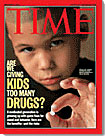
.gif) |
.gif) |
.gif) |
.gif) |
 |
.gif) |
|
|
.gif) |
 |
 |
 The
Human Brain The areas of the brain that are
affected by mental
disorders The
Human Brain The areas of the brain that are
affected by mental
disorders
| |
|
| |
.gif) |
.gif) |
.gif) |
.gif) |
 |
 |
 |
 |
 |
 |
| E-mail
your letter to the editor | |
 |
 |
 |
 | |
|
Posted Sunday, Oct. 26,
2003
Going away to college isn't the same these
days. Once upon an All-American time, Mom and Dad unloaded the
station wagon as their starry-eyed scholar surveyed the campus
with a heart full of hope and a mind on fire with plans. The
mood was wistful and optimistic; the future looked bright
despite the tearful farewells.
But a shadow has fallen among the ivory towers. A growing
number of students arrive on campus suffering from depression
and other emotional disorders—some diagnosed, some hidden. So
that traditional moment of new beginnings is haunted by deep
anxiety and gloom.
A rapid-fire trio of student suicides at New York
University this fall has focused attention on the problem. On
Sept. 12, a day after celebrating his 20th birthday, Jack
Skolnik of Evanston, Ill., leaped to his death from the
10th-floor inner balcony of the campus library. One month
later, Stephen Bohler, 18, of Dayton, Ohio, made the same
fatal dive. Finally, on Oct. 16, Michelle Gluckman, 19, a
sophomore from Brooklyn, N.Y., threw herself from the
sixth-floor window of an off-campus apartment.
Behind these deaths lurk an array of grim statistics that
show how prevalent mental disorders have become on campus.
Data from a 2001 survey of college mental-health counselors,
when compared with past findings, revealed that the percentage
of students treated at college counseling centers who have had
psychological problems diagnosed and are taking psychotropic
drugs increased from 7% in 1992 to 18% in 2001, according to
Greg Snodgrass, director of the counseling center at Texas
State University. The survey also found that during the
previous five years, 85% of North American student counseling
centers reported an increase in students with "severe
psychological problems." Colleges have responded by beefing up
mental-health services, including suicide-watch programs.
Harvard set the standard in 1998—after a widely publicized
campus murder-suicide case—by increasing staff 25%. "One huge
issue was access," explains Dr. Richard Kadison, who heads
mental-health services there.
Are today's students more emotionally fragile than their
predecessors? No one can say, though some point to grueling
pressures to succeed in an era of economic uncertainty and
heightened parental expectations. Hal Pruett, director of
student psychological services at UCLA, recalls a tense
freshman who became so distracted by inner turmoil that he
couldn't study. "He kept saying, 'I can't afford to get a C.'
I asked why, and he said, 'I won't get into medical school,
and my parents will disown me.'"
Hara Estroff Marano, an editor at Psychology Today
who has interviewed college counselors and their students
about depression, wonders what happened to sharing one's
worries with roommates and friends. A depressed student told
Marano she wouldn't dream of telling peers about her darker
fears because she saw them as rivals, scrambling for the same
grades and grad-school slots. "For many in this generation,"
says Marano, "there is a sense that you can't show any
vulnerability." Pruett wonders if the reliance on medication
to handle the blues hasn't weakened some students'
nonpharmaceutical coping skills. "Sometimes we need to value
our ability to solve and work through problems," he says.
"Prescribing a drug sometimes deprives these young people of
that age-old human ability."
The prescriptions may be saving lives, though. As the rate
of their use on campus has gone up, overall reported college
suicide rates, despite the cluster at N.Y.U., have fallen
noticeably, from a total of 122 in 2000 to 80 in 2001. "It's
the Prozac payoff," says Marano. That and the determined
efforts of campus mental-health professionals to diagnose
depression early, treat it aggressively and reassure students
that the sunny college careers of yesteryear represent an
ideal and not always a reality.
—Reported by Simon Crittle/New York and Sonja
Steptoe/Los Angeles
|
|










